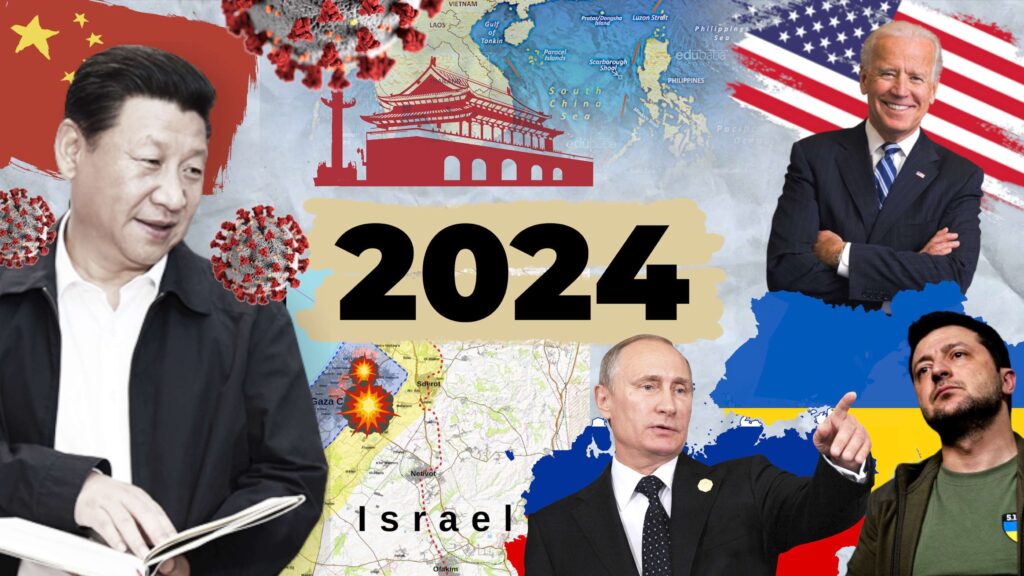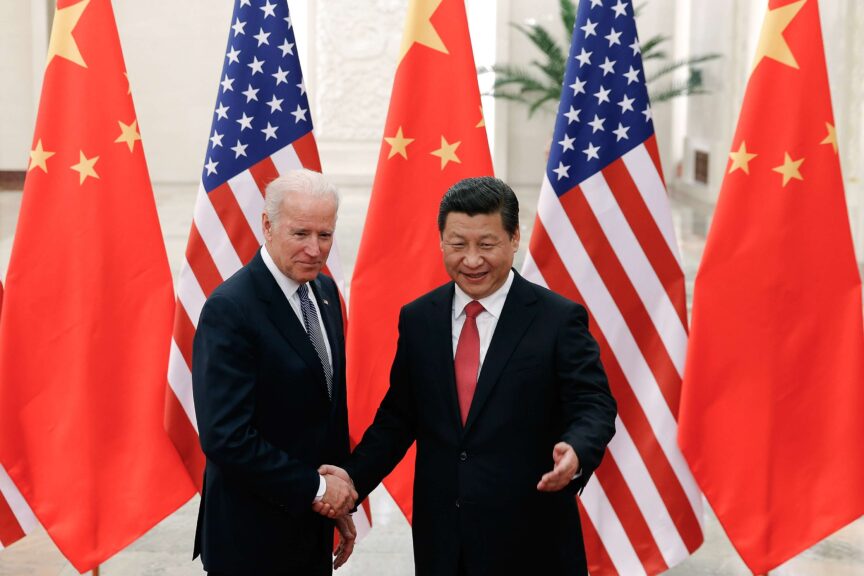
2024 Outlook: My team has compiled a list of seven key forecasts, highlighting potential military conflicts and economic and geopolitical developments. The prognoses include tensions between Israel and Hamas, ongoing strife between Russia and Ukraine, fluctuations in China’s economy, and the possibility of unrest in the Taiwan Strait among others. Dive into the details to learn more about what the year may hold!
The Russia-Ukraine War
Prediction: There will be a truce and the peace negotiation will start.
Recent statements by Kremlin spokesperson Peskov highlight a persistent impasse, with no immediate prerequisites for negotiations acknowledged as of late December. Yet, the very acknowledgment of such conditions, negative though they may be, marks a departure from previous periods where the notion of negotiations was not even on the agenda. This subtle shift could indicate an evolving stance as both nations consider the long-term sustainability of ongoing hostilities.
With U.S. and European support for Ukraine under strain, there appears to be a strategic recalibration towards enhancing Ukraine’s negotiating capabilities. An unnamed White House official has suggested that the endgame for the conflict lies in diplomatic dialogue, aiming to position Ukraine advantageously for such an outcome.
The conflict has gained prominence in the political arena, particularly in the United States, as the presidential election approaches. The Biden administration’s ability to continue military support faces challenges, with significant aid requests stalled.

European diplomatic efforts also hint at a shift, with suggestions of expediting Ukraine’s NATO membership being used as leverage to bolster Ukraine’s position in potential negotiations with Moscow.
Military developments reflect a relative stalemate, which some speculate could lead to a Russian willingness to negotiate, provided specific territorial controls are maintained. This perspective was noted in a report by The New York Times on December 23, suggesting a possible opening for compromise.
In summary, while definitive predictions remain elusive, the current trajectory of the Ukraine-Russia conflict suggests that 2024 may bring new developments. Although speculative, a truce and the commencement of peace negotiations represent one possible path forward as both nations grapple with the prolonged toll of war.
Israel-Hamas Conflict in 2024
Prediction: Hostility will persist with escalation likely.
The Israel-Hamas conflict in 2024 continues to evolve, marked by significant developments and heightened international involvement. The United States, spearheaded by Secretary of State Antony Blinken, has declared resolving this conflict a primary objective. Despite these efforts, the situation remains entangled in complexity and volatility.

The humanitarian conditions in Gaza have deteriorated significantly. Israeli airstrikes have relentlessly targeted central and southern Gaza, with the Maghazi refugee camp experiencing severe devastation. However, the ongoing conflict has implications that extend beyond the immediate geographic area. It has led to an increased deployment of U.S. military forces in the region and escalated tensions along the Israel-Lebanon border. Furthermore, there appears to be little prospect of the conflict fostering renewed peace efforts or advancing a two-state solution.
Sustained military engagements, considerable impact on civilians, intricate international diplomatic efforts, and significant regional consequences define the Israel-Hamas conflict in 2024. The path to resolution remains unclear, as both sides hold firm to their positions amidst an increasingly complex geopolitical landscape.
The South China Sea
Prediction: Strife will continue and intensify.
The situation in the South China Sea for 2024 appears to be increasingly tense and complex, involving multiple nations and escalating confrontations. Here are some key points based on the latest information:
Philippines and China Tensions: The Philippines is bracing for further escalations from China. Philippine President Ferdinand Marcos Jr. has been vocal about defending the nation’s sovereignty, shifting from his predecessor’s more China-friendly stance. This assertiveness from the Philippines and China’s continued provocations suggests an increasing likelihood of escalation.
US-China Dynamics: The South China Sea is also a potential flashpoint for US-China tensions. The U.S. has regional alliances and strategic interests, notably with the Philippines. Any military confrontation between China and its neighbors could potentially draw in the U.S., further escalating the situation.
Regional Implications: Other ASEAN countries, such as Vietnam and Malaysia, are also involved in the South China Sea disputes. Their actions, from oil drilling operations to territorial claims, add layers to the already complex situation.
Grey Zone Tactics and Risks of Escalation: While these actions have so far avoided direct military conflict, there is a growing concern that continued provocations could lead to a more serious confrontation, especially with the increased assertiveness of other nations like the Philippines.
The situation in the South China Sea in 2024 is marked by rising tensions, with significant risks of escalation involving major regional players.
The Taiwan Strait
Prediction: The situation is most uncertain as it will be contingent upon the outcome of the January presidential election.

The January 13th elections in Taiwan are seen as a significant event that could shape the island’s relations with Beijing. The presidential race features candidates with opposing ideas on how to handle tensions with China, which claims Taiwan as part of its territory.
While Taiwan has reported increased military activities, such as the presence of Chinese fighter jets and warships around the island, Taiwan’s defense ministry has not indicated signs of large-scale military movements.
Beijing is particularly concerned about a potential DPP victory, as it would prefer to avoid another administration in Taipei that it sees as working toward Taiwanese independence. China’s measures have included military aircraft deployments near Taiwan and economic pressures such as the suspension of tariff relief on some Taiwanese imports.
The United States and other regional powers are also paying close attention to the elections, given that Taiwan remains a sensitive issue in US-China relations. Communications between Washington and Beijing are important in preventing escalating tensions.
Japan, another key regional player, is focused on the candidates’ positions regarding engagement with China and is keen on maintaining the status quo across the Taiwan Strait. Like other countries in the region, Japan has been adjusting its defense and security policies in response to the rising tensions.
Overall, while the election’s outcome may not fundamentally alter the dynamics across the Taiwan Strait, it is expected to influence how China, the U.S., and other regional powers interact with Taiwan and address broader regional security concerns. The geopolitical landscape post-election will require careful navigation by all parties involved.
US-China Relations
Prediction: Both leaders need the relations to stay the course with fewer disruptions.

Our analysis of the Sino-US relations for 2024 focuses on the respective domestic situations of both leaders. The dynamic suggests a more stable phase in the relationship, driven by several factors:
Domestic Challenges of Xi Jinping: Xi Jinping’s domestic economic and political challenges could influence China’s foreign policy. Leaders facing internal pressures often seek stable international environments to focus on domestic issues. This could mean a more cautious approach to the relations with the United States.
Biden’s Upcoming Election: The political climate in the U.S. during an election year can significantly impact foreign policy. Biden is wary of the potential impact a falling Chinese economy has on the U.S. economy in the election year. He may avoid radical policy shifts in election years to maintain a sense of stability and continuity, which could mean a more measured approach toward China.
Global and Regional Context: The global and regional context, including economic interdependencies, shared challenges like climate change, and regional security issues, also play a role. Both countries might temporarily find common ground or at least reasons to keep tensions in check.
However, it’s important to consider that international relations are complex and can be influenced by unforeseen events or changes in the domestic or international environment.
Worldwide deflationary effects of the Chinese economy
Prediction: China will export deflationary economy across the globe

The outlook for China’s economy in 2024 suggests several challenges that may contribute to the export of a deflationary effect across the globe. Here are the arguments and facts to support this point:
Deflationary Pressures: China’s deflation pressures have worsened recently, with the consumer price index (CPI) recording significant drops, reflecting weak domestic demand. Producer price inflation (PPI) has also remained negative for an extended period.
Policy Responses: There’s uncertainty about the Chinese government’s policy responses to the deflationary trend. While some stimulus measures have been taken, they may not be aggressive enough to counteract deflationary pressures effectively.
Impact on Global Prices: China’s declining export prices will likely translate into lower import prices for other countries, contributing to global disinflation. J.P. Morgan Research estimates that China’s deflation could lower global core goods inflation (excluding China) significantly over the second half of 2023, a trend that may continue into 2024
Weakening Consumer Confidence: Consumer confidence in China remains low, with households opting to save rather than spend. This increased savings rate and high unemployment rates, particularly among the youth, have reduced consumer spending, further contributing to deflationary pressures.
Real Estate Market Downturn: The downturn in China’s real estate market continues to impact consumer and business confidence negatively, likely contributing to the weakening of economic growth. Despite government measures, the real estate market has not seen a significant revival.
Industrial Production Slowdown: Industrial production growth has slowed down, and investments in fixed assets have not kept pace with previous years. Chinese factories face weaker demand both domestically and in export markets, which is likely to dampen economic performance and contribute to deflationary pressures.
Global Manufacturing Impact: As China is a significant player in the global manufacturing sector, a slowdown in Chinese manufacturing due to internal and external challenges could lead to excess capacity and inventories, putting downward pressure on prices globally.
Foreign Direct Investment (FDI) Concerns: FDI in China has seen a decline, reaching its lowest since 1998. Political tensions and regulatory changes are making foreign companies cautious about investing in China, which could impact China’s economic dynamism and contribute to deflationary trends.
Export Dynamics: The depreciation of the yuan and the decrease in China’s export prices are reducing the costs for China’s downstream producers. This, in turn, is likely to enhance the deflationary spillover for the rest of the world as export price declines become more substantial.
Given these factors, if the trend of a deflationary Chinese economy continues, it could indeed lead to an export of deflationary pressures to the global economy in 2024, affecting a range of sectors, including the automotive industry, where Europe has expressed concerns over cheaper E.V.s made by Chinese manufacturers.
Global migration crisis
Prediction: New regulation will attempt to mitigate the crisis
Forecasts by various national governments and organizations such as the OECD have developed scenarios for global migration, with predictions of an increase in average annual global migration flows by 2030. Furthermore, the International Rescue Committee (IRC) has highlighted crises that cannot be ignored in 2024, such as the effects of climate change, conflict, and economic conditions leading to food insecurity and displacement, which will certainly impact migration patterns.
However, it’s important to note that migration forecasts often come with high levels of uncertainty. A Delphi survey involving experts predicted that by 2030, total yearly immigration flows to the European Union could increase by 21 to 44 percent compared to previous years. Yet, the level of confidence in these predictions was relatively low, indicating substantial disagreement among experts.
While new regulations in 2024 may attempt to mitigate the migration crisis, the success of these measures will likely depend on a complex interplay of global events and the adaptability and responsiveness of the policies to the dynamic nature of migration.
Here is a video on CCP’s 3 black swan events in 2024.







